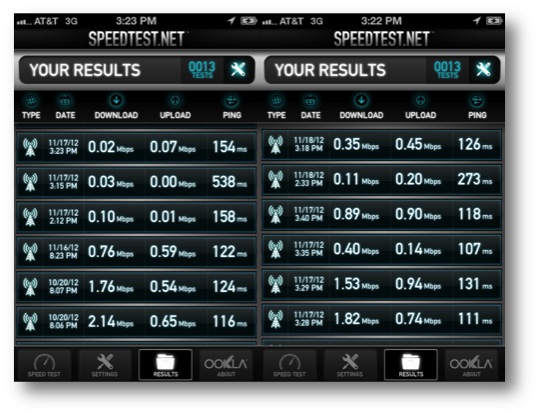Why Consumers of U.S. Wireless Carriers Need a Google
With talk recently of Google exploring the wireless market it is a good time to start thinking about why consumers of U.S. wireless carriers need a Google. In August of 2012 AT&T filed to be classified not as Telecommunications provider but as an “Information Service” in the U.S. This is basically means they are not beholden to provide telephony services to the rural U.S. as the “carrier of last resort”. This would permit traditional incumbent local exchange carrier (ILEC) to follow the profit rather than servicing the communities they collect federal subsidies to service.
Wireless Service Carriers Positioning
Recently, AT&T announced plans to invest $14 Billion into their U.S. wired and wireless infrastructure. In an article written by Bruce Kushnick the Executive Director, New Networks Institute wrote a piece titled AT&T’s $14 Billion Dollar ‘Bribe’ to Get Rid of Telecom Regulations Is a Multi-Layered Hoax in the Huffington Post, in which he laid out scathing analysis. He also points out, this is not the first time AT&T and other wireless carriers like Verizon, have made this commitment without delivering.
“Whether you call it extortion or a bribe or a bait-and-switch — this sudden interest in wired services is being used to force the regulator’s hands, on both the state and federal level: Give us what we want or we won’t bother to do anything. AT&T is holding 22 states’ economic future hostage.” – Bruce Kushnick Huffington Post
There is a clear evidence that Internet access can be a catalyst for economic development. Both are directly and indirectly coupled to moving the stimulus needle in depressed local U.S. economies. An OpEd from Craig Settles, Gigabit Nation weighed both sides of the coin in this article posted on GigaOM
“Throwing broadband at a problem isn’t going to change deeper problems. It’s a lever for change, not a magic wand. Policymakers (many well-intentioned), government agencies, and elected officials, as well as big telecos’ lobbyists conning their way into more government subsidies for empty broadband promises, seem to fall into two camps hindering progress.” – Getting beyond the magic broadband bullet theory- GigaOM
“Throwing broadband at a problem isn’t going to change deeper problems. It’s a lever for change, not a magic wand. Policymakers (many well-intentioned), government agencies, and elected officials, as well as big telecos’ lobbyists conning their way into more government subsidies for empty broadband promises, seem to fall into two camps hindering progress.”
In its (FCC) work, the agency seeks to capitalize on its competencies in:
- Promoting competition, innovation, and investment in broadband services and facilities.
- Supporting the nation’s economy by ensuring an appropriate competitive framework for the unfolding of the communications revolution.
- Encouraging the highest and best use of spectrum domestically and internationally.
- Revising media regulations so that new technologies flourish alongside diversity and localism.
- Providing leadership in strengthening the defense of the nation’s communications infrastructure.
“Capitalize” is an ironic choice of words. None of the above spells consumer advocacy to me and all of it spells avoiding change of the status quo.
My Perspective
The promise of the cloud and mobility sounds great. For some things it is great. Gmail is flawless, Evernote always there. Then you leave the comforts of an Ethernet based network, head to a meeting somewhere, go to the airport and decide to take advantage of some of these great apps on our wonderful smart phones. You quickly realize, you are paying close to $100 a month to have someone waste your time.
Figure 1. These are random speed tests from my iPhone 4 in an urban city using SpeedTest.net. I encourage everyone to install this app and measure what you are paying for versus what you are actually receiving. Most of the time I am within line of site of the cell tower and I know that instead of a bundle of fiber at the base of the tower what is really there are decades old copper oversubscribed T1’s. These numbers do not represent wireless spectrum problems, but exemplify insufficient backhaul capacity.
These performance metrics are often times not enough for one to simply check email, much less, run the next “killer app”.
Wireless Service Market Needs Disruption
There are roughly ~300 million “smart” devices connected to the Internet in early 2012. By 2020, various analyst predict between 30-50 billion devices. If we are not engaged and demanding holistic plans today, important innovations that will improve economic development, education and life safety in the future, will be be put on hold indefinitely.
Competition solves many problems. Hopefully, the playing field will not be restricted by lobbyist efforts in D.C. We will certainly be watching the Google’s recent interest in the cellular market as they have begun courting Dish TV who is wireless spectrum rich. The wireless carrier market needs disruption from a cash rich source like a Google, Apple or Amazon to break the choke-holds on our national infrastructure. A fresh start from a Google like, cash rich, company might be enough to force enough competition for wireless operators to get serious about improving service delivery.
For us to achieve the grandeur, that is the promise of ubiquitous access, we need to find business models that take into account everyday citizens and not just shareholders on Wall Street. The cellular carriers are in the way, what consumers, lawmakers and carriers need to figure out is how to fix it.

















For ubiquitous business model for access agnostic could be PMIPv6. Wherein MVNO could be deployed with same or different back haul with any combination of access network too.